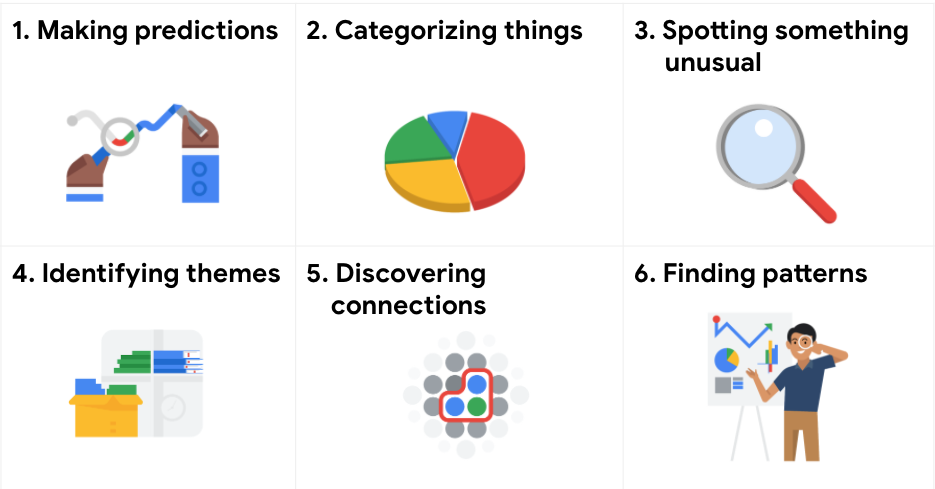Understanding the Six Core Problem Types Data Analysts Tackle for Effective Solutions
- Trí Quang
- 4 days ago
- 3 min read
Updated: 2 days ago
Data analytics goes beyond merely inserting information into a software program; it's fundamentally about solving real-world problems. The journey to find solutions starts with a clear understanding of the issue at hand. Once you grasp the problem, you can take a strategic approach to your analysis, deciding on the key information to include, how to manipulate the data, and its potential uses.
Data analysts regularly face six distinct problem types, each requiring specialized skills and approaches. Recognizing these types can significantly enhance decision-making processes, leading to more effective data-driven results.

1. Making Predictions
Making predictions is perhaps the most recognized task for data analysts. A good example of this is when a retail chain wants to understand which advertising channels will attract the most new customers. Analysts can utilize past data, such as customer demographics and response rates from previous campaigns. For instance, if 60% of new customers in the last quarter responded positively to social media ads, this insight can guide future marketing strategies.
Being able to predict which ads will yield the best results enables businesses to allocate their marketing budgets more wisely. Additionally, analysts can forecast sales trends, helping businesses adjust their inventory based on expected demand, improving efficiency and profit margins.
2. Categorizing Things
Categorization is another essential task for data analysts. Consider an online store that wants to improve its customer service. Analysts might classify customer queries using specific tags based on the issue type, such as shipping delays or product defects. If data shows that 75% of customer complaints relate to shipping, the business can focus on that area for improvement.
This classification process helps firms identify areas for training employees and refining processes, leading to enhanced customer relationships and overall satisfaction.
3. Spotting Something Unusual
The ability to spot anomalies is crucial, especially in areas where health or safety is concerned. For instance, a company selling health-monitoring devices can analyze health trends in user data. If data shows that a unique spike in heart rate occurs after using a specific feature, analysts can examine if this correlates with user health changes.
Recognizing these unusual trends early can lead to vital product improvements and better foresight into customer health needs, ultimately saving lives and elevating product reliability.
4. Identifying Themes
Identifying themes is key for understanding customer sentiment. For example, a restaurant chain might analyze feedback collected from online reviews. Suppose they find that 80% of customers rate their service as excellent but cite long wait times as a consistent complaint. This information can lead the company to implement changes in staff training or reconfigure seating to improve service speed.
By understanding underlying themes in customer feedback, organizations can tailor their offerings and create experiences that resonate more profoundly with their clientele.
5. Discovering Connections
Discovering connections is vital for uncovering relationships among various data points. For example, a beverage company might investigate the impact of holiday promotions, pricing strategies, and seasonal trends on sales. By analyzing data, they may find that a 15% price reduction during the holidays leads to a 40% sales increase compared to regular pricing.
Understanding these connections allows businesses to navigate their operations better and develop strategies that would otherwise remain unexplored, increasing productivity and profitability.
6. Finding Patterns
Finding patterns involves digging into behavior trends within data. An online bookstore, for example, could analyze customer browsing patterns to see which genres or titles frequently lead to purchases. If data shows that customers who buy romance novels often purchase holiday-themed books shortly after, targeted marketing efforts can be developed to boost sales in those categories.
Recognizing these patterns helps businesses optimize inventory and tailor marketing efforts, thereby enhancing the customer experience and driving sales growth.
Final Thoughts
Data analysts navigate six vital problem types essential for effective data-driven decision-making: making predictions, categorizing things, spotting anomalies, identifying themes, discovering connections, and finding patterns. By having a clear understanding of these problem types, organizations can leverage data to address complex challenges and drive success.
In today’s data-centric world, the insights derived from thorough analysis can significantly influence business outcomes. By adopting a systematic problem-solving approach, organizations ensure that they make informed decisions aligned with their strategic objectives.
As the demand for skilled data analysts grows, understanding these core problem types will empower them to deliver insights that lead to effective solutions. Embracing these concepts not only enhances analysts' capabilities but also equips organizations for success in an ever-evolving market landscape.



Commentaires